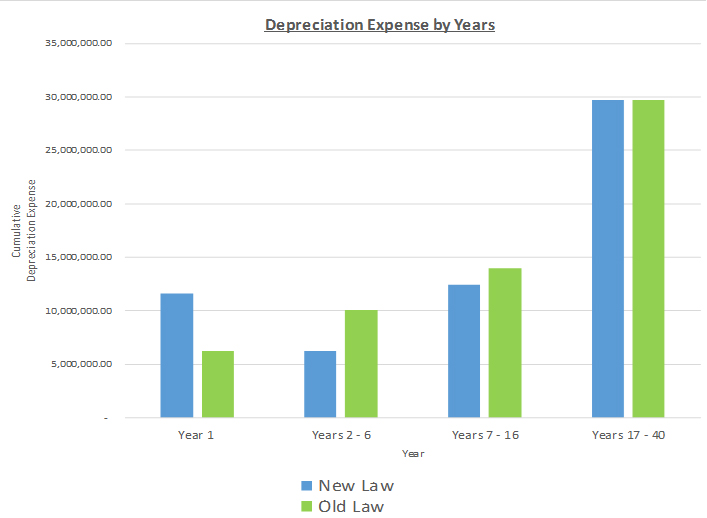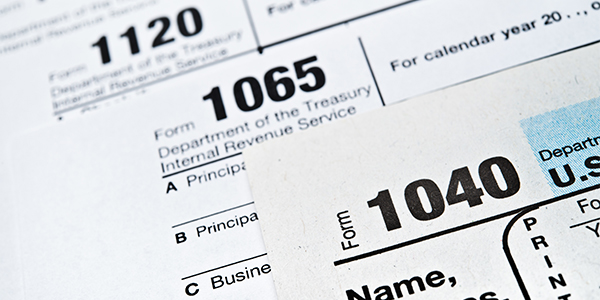Appreciation for Depreciation
The Tax Cuts and Jobs Act contains many major changes to the tax landscape that will affect every type of business entity, both large and small. The new tax reform creates significant opportunities to minimize a business’s overall tax burden.
Perhaps the most impactful—and favorable—legislation to the real estate industry is the changes and modifications to depreciation rules. Here we highlight key components that impact the commercial real estate industry and provide a comparison between the current and new tax laws.
Under prior tax law, most assets held in rental real property were required to be depreciated over periods typically ranging from 5-39 years. Assets with 20-year class lives or less were normally eligible for 50% bonus depreciation, which means we could deduct 50% of the asset in the first year and depreciate the rest over the remaining life of the asset. Under the new law, those same assets are now eligible for a 100% deduction in the year placed in service. Congress has also expanded bonus depreciation to acquisitions, which were not eligible in years past. This is a huge benefit for real estate in many ways, as it allows for significant tax write-offs in the first year for acquisitions, new developments, and redevelopments.
At Stirling Properties, we contract out a cost segregation study on all of our new acquisitions, developments, and redevelopments. These studies allocate the purchase price of the asset into its proper class life. The resulting history allows us to estimate what depreciation will look like on the project during underwriting. On the front end of our due diligence, we have an accurate idea of how much of the purchase price is going to be eligible for the new 100% bonus depreciation. For a $60 million acquisition or development, we estimate that as much as 20% of that investment can be expensed in year one, resulting in over $11 million in depreciation. As you can see in the chart below, depreciation expense has approximately doubled in year one as compared to the old law. The net present value (NPV) of the tax savings resulting from being able to deduct the additional depreciation in year one is over $500,000.
Similarly, ongoing operations of the property will be impacted considerably. To attract and retain high-quality tenants, landlords typically provide tenant improvement allowances which result in enhancements to the occupant’s space that revert to the landlord upon lease expiration. Under the prior law, these tenant improvement allowances were typically eligible for 50% bonus depreciation and the balance depreciated over 15 years. Under the new law, these allowances will be eligible for a 100% deduction in the year placed in service.
Investing in real estate can be a tax advantageous way to deploy capital, especially for individuals or companies that have significant recurring income tax burdens such as financial institutions. We anticipate that the new tax law will lead to higher demand for quality assets helping to keep deal flow robust, thus attracting more buyers and investors into the real estate arena. At Stirling Properties, we will continue to utilize this new tax law for the best interest of our properties and investors.
Disclaimer: The information contained herein is intended for information purposes only. Individuals should seek advice directly from a qualified professional before making any decisions or taking any action that might affect your personal finances or your business. Stirling Properties is not responsible for any investment or monetary decisions made based on the information provided above and is not a tax advisor. The information provided above was done so with the perceived intent of the legislation and not based on the actual regulations. The actual regulations could yield significantly different results.
Tax Reform & Real Estate… It’s a good time for our industry
The Tax Cuts and Jobs Act passed in December and several of these provisions will take effect in 2018. Many individuals have already benefited from the new tax law by seeing their recent paychecks increase. We believe this tax reform will have a similar positive impact on the real estate industry. Tax reform can be a very complicated—and tedious—topic so we’ve highlighted some of the implications for real estate owners, small business owners, and individuals. We’ll preface by saying this is our interpretation of the law, prior to the regulations being written and what we think Congress intended by the text of the law.
Initially, many of us in the real estate industry were very concerned about tax reform and the negative aspects that were being considered. The International Council of Shopping Centers (ICSC), responded by forming a committee consisting of executives and tax professionals across our industry to garner input to deploy lobbying efforts. Stirling Properties played a significant part in providing consistent feedback that guided ICSC’s lobbying efforts. Several executives in our company, including Marty Mayer, Townsend Underhill, Jimmy Maurin, Will Barrois, and me, were active in lobbying congress, and as noted below, these efforts were successful. Together, we were able to quickly respond to aspects of the tax proposal that were detrimental to the real estate industry and offer solutions that would benefit our real estate holdings and the business as a whole. We’ve compiled a brief overview of some of the changes.
Real Estate Business Owners and Investors
- Expanded Bonus Depreciation: Items that were previously required to be capitalized over 15 years (subject to 50% bonus depreciation) are now eligible for a 100% deduction in the year of completion.
- Examples of these items include parking lots, landscaping work, pylon lighting, etc.
- This provision begins to phase out after 5 years.
- Business Income Deduction: 20% of the taxable income generated from a business could be eligible to be deducted from taxable income pending multiple limitations.
- For example, if your share of taxable income from a business you own is $100,000, the first $20,000 may be eligible for a deduction, thus lowering taxable income to $80,000.
- Business income from pass-through entities like partnerships and LLCs will still be taxed at the new lower individual rates.
- Historic Preservation and Rehabilitation Tax Credit: The 20% credit for renovating certified historic structures remains in place but must be taken over a 5-year period as opposed to being fully deductible in the year of completion under the existing law.
- C-Corporations Tax Rate: The corporate tax rate under the new law is 21% as compared to 35% under the existing law.
- Property Tax Deduction: Still in place for real property trade or businesses including rental properties.
- Interest Expense from Loans: Businesses will still be eligible to deduct the interest expense from the debt incurred if its gross receipts are less than $25 million.
- The vast majority of commercial real estate in the Gulf South region would continue to be eligible to deduct interest.
- 1031 Exchanges: Real estate will still qualify to receive 1031 treatment.
- Capital Gains Rates: Remained unchanged at 0%, 15%, and 20% depending on income levels.
- Carried Interest: The new law requires a 3-year holding period to qualify for capital gains treatment as opposed to a 1-year holding period under the current law. This was a “win” for real estate as the original proposal was for carried interest to be taxed at ordinary rates.
Individuals
- Tax Rates: Almost every bracket has been widened and lowered with the top bracket being lowered from 39.6% to 37% thru 2025.
- Standard Deduction: Single filer’s standard deduction increased from $6,350 to $12,000. Married filer’s standard deduction increased from $12,700 to $24,000.
- Personal Exemptions: Taxpayers will no longer be eligible to deduct the $4,100 per dependent.
- Child Tax Credit: The child tax credit increased from $1,000 to $2,000.
- State and Local Taxes: Deduction under the new law is capped at $10,000.
- Estate Tax Exemption: Doubled to $11.2 million for single filers and $22.4 million for married couples.
At the end of the day, the real estate industry appears to have fared well in the Tax Cuts and Jobs Act. Some of these items are pending a technical corrections bill and additional clarification, but the expanded bonus depreciation and business income exclusion make being a real estate investor an enticing proposition. For investors looking to deploy capital in a tax advantageous investment, real estate is an appealing option that will rival alternative investments. We believe tax reform will provide a stimulus for real estate investment over the next five years.
We will follow up with more in-depth coverage of some of these items in the future, as well as how Stirling Properties is adapting to take advantage of this new opportunistic landscape.
The information contained herein is intended for information purposes only. Individuals should seek advice directly from a qualified professional before making any decisions or taking any action that might affect your personal finances or your business. Stirling Properties is not responsible for any investment or monetary decisions made based on the information provided above and is not a tax advisor. The information provided above was done so with the perceived intent of the legislation and not based on the actual regulations. The actual regulations could yield significantly different results.
Beware the Broad Brush
There has been much debate in the media this week about Donald Trump’s taxes and the need for Congress to overhaul America’s tax system. In yesterday’s editorial debate of the USA Today, the editorial board makes its point for real estate tax policy reform and the overly generous tax benefits received by commercial real estate property owners.
The opposing viewpoint, authored by Real Estate Roundtable President and CEO, Jeff DeBoer, emphasizes that all business investments, including real estate, be allowed to recover its capital investment cost through depreciation and amortization. He goes on to point out that it is irresponsible to specifically target the tax structure of the real estate industry, which accounts for a large percentage of America’s jobs and economic activity.
The current value of the US commercial real estate investment is approximately $6.0 trillion, leveraged conservatively at approximately 55% (over $2.7 trillion of equity; $3.3 trillion of debt). This investment is responsible for billions of dollars in economic activity, supports approximately 9 million American jobs, and contributes 13% of the nation’s gross domestic product. Real estate activity accounts for nearly 25% of the taxes collected at all levels of government, including income, property and sales taxes. Property taxes alone constitute 40% of the state and local tax base. Taxes derived from real estate ownership and transfer represent the largest source, which in some cases, is approximately 70% of local tax revenues, helping to pay for schools, roads, law enforcement and other essential public services.
Further, the US real estate industry is an inherently domestic product that cannot be offshored through inversions or other tax schemes. If Congress does take on Tax Reform in 2017, it should be noted that much of our country’s real estate investment is made locally by individuals seeking solid, long-term returns with a desire to improve their neighborhoods and serve the communities in which they live.
Let’s not use Mr. Trump’s personal tax situation as a means to hurt our local communities and our nation’s economy by using a broad brush approach!






